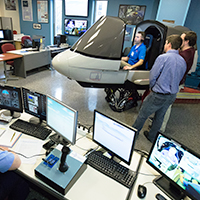
Merlin Flight Simulator Lab
Students Reach New Heights
The Merlin Flight Simulator Lab is primarily used by Aero concentration students, though it is open to anyone interested. Students access the simulator through either the Department of Mechanical and Aerospace Engineering or the Flight Handling Club. Club members are students interested in aircraft design and range from first-year students to graduate students.
MEE 225 Intro to Flight, MEE 440 Flight Vehicle Dynamics, MEE 425 Air Vehicle Design (Capstone) are courses associated with the Lab, but MEE 432 Capstone Mechanical Design projects and a graduate human factors class have used the Lab too. Several graduate versions/sections of the aforementioned classes also use the Lab.
MEE 225 Intro to Flight
Like most aero concentration students, you’ve been attracted to the discipline because air vehicles evoke an emotional response from you. You’re not quite sure whether or not you want to be an aerospace engineer because you don’t really know what aerospace engineers do. But you find aerospace vehicles are interesting and engaging.
Most of you have never flown a real airplane. Many of you have never even been on a real airplane. How do I decide if I want to be an aerospace engineer??
A good place to start is in the cockpit of a simulated airplane. You can start from (no pun intended) the ground up! What are the primary control surfaces on an airplane and how do they affect movement about the three primary axes? How do they interact? How does this change when you move your airplane’s center of gravity fore or aft? What’s the difference between how a docile basic trainer like a Cessna 152 and a high performance fighter handle? What does an underpowered airplane feel like? Overpowered? These are all questions that students can not only see, but feel the answers in the simulator. The simulator exercises represent experiential and hands-on learning in unique ways.
MEE 440 Flight Vehicle Dynamics
You’ve had your MEE 225 Intro to Flight and MEE 401 Aerodynamics classes. You are slowly beginning to see how all of these areas of study interact to make the airplane fly the way it should. Now it’s time to start understanding how the airplane behaves in three-dimensional space. You will once again experiment with changing the center of gravity of the airplane, but this time you will output the long and short period oscillation amplitude as a function of time. You will analyze how this changes in the longitudinal axis as center of gravity is moved, or horizontal volume is changed. You will also investigate how motions commanded about a single axis result in motion about other axes through cross coupling reactions. These reactions can also be output by the simulator, analyzed and eventually even modeled using the governing equations and some assumptions. In short, the mathematics will be explained, physically manifested and sensed through the simulator model. The simulator’s reaction will be documented, output, analyzed and modeled. These exercises will be performed under a variate of different input conditions in the simulator.
MEE 425 Aerospace Vehicle Design
Imagine choosing to design the airplane of your dreams . . . for a class! Then, after working diligently on your own individual airplane design, imagine what it would be like to move the throttle levers forwards for the first time. Imagine the sensation as your airplane takes flight for the first time! It probably won’t fly the way you wanted it to, or even the way you expected. So you’ll have to go back and learn a lot more about the airplane to figure out what kinds of modifications result in the handling qualities you are seeking for your design.
Now that you’ve iterated on the design, and the airplane performs the way you think it should, it’s time to be thankful for the wonderful volunteers from the local Society of Experimental Test Pilots (SETP). These experimental test pilots will fly your plane with you present. Now you get feedback from professional experimental test pilots on the handling qualities of your airplane. WOW! What a high gain academic experience! You’ll learn to correct your design for things that you didn’t even know existed before your interaction with the test pilots! They will put your airplane through its paces and point out strengths as well as areas for improvement. This allows you to close the loop on the aircraft conceptual sizing process in unique ways unavailable to most.
Outreach and Research
The lab has been used in outreach activities ranging from pre-school all the way through seasoned professional engineers. Research projects have involved modifications to existing competing designs for the USAF TX-Trainer program as well as models of the Wright B Inc.'s Brown and Silver Birds.

